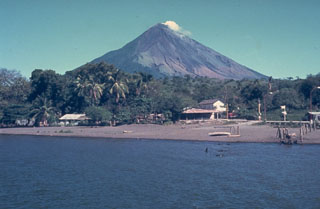Report on Concepcion (Nicaragua) — February 1989
Scientific Event Alert Network Bulletin, vol. 14, no. 2 (February 1989)
Managing Editor: Lindsay McClelland.
Concepcion (Nicaragua) Cool fumarole on the crater rim
Please cite this report as:
Global Volcanism Program, 1989. Report on Concepcion (Nicaragua) (McClelland, L., ed.). Scientific Event Alert Network Bulletin, 14:2. Smithsonian Institution. https://doi.org/10.5479/si.GVP.SEAN198902-344120
Concepcion
Nicaragua
11.538°N, 85.622°W; summit elev. 1700 m
All times are local (unless otherwise noted)
Observations during a 17 February visit by geologists from INETER and Open Univ were limited by poor weather, and the fumarolic area N of the crater was inaccessible. Gas that rose gently over the crater rim felt warmer than the 16°C ambient temperature. A fumarole found on the crater rim was cooler than 100°. Large amounts of dead vegetation on the E flank were attributed to the 1982 ash eruption.
Geological Summary. Volcán Concepción is one of Nicaragua's highest and most active volcanoes. The symmetrical basaltic-to-dacitic stratovolcano forms the NW half of the dumbbell-shaped island of Ometepe in Lake Nicaragua and is connected to neighboring Madera volcano by a narrow isthmus. A steep-walled summit crater is 250 m deep and has a higher western rim. N-S-trending fractures on the flanks have produced chains of spatter cones, cinder cones, lava domes, and maars located on the NW, NE, SE, and southern sides extending in some cases down to Lake Nicaragua. Concepción was constructed above a basement of lake sediments, and the modern cone grew above a largely buried caldera, a small remnant of which forms a break in slope about halfway up the N flank. Frequent explosive eruptions during the past half century have increased the height of the summit significantly above that shown on current topographic maps and have kept the upper part of the volcano unvegetated.
Information Contacts: C. Oppenheimer and D. Rothery, Open Univ; B. van Wyk de Vries, O. Castellon, and L. Urbina, INETER.

